Do you love the ocean and sharing your passion with other like-minded people? Do you wish your office was full of white sand and turquoise water? Are you ready to turn your passion for diving into a real career? Then you should sign up for the PADI Instructor Course and become a Scuba Diving Instructor! Our next IDC dates are coming up soon; from the 21st November - 2nd December 2022, and here's why we think you should sign up right away....
The decision to become a dive instructor can be a very difficult one. With so many choices of locations, lengths and internship styles out there it can be tricky to know where to start. Here at Scuba Junkie we offer a range of different options for the PADI Instructor Development Course, all of which are designed to not only give you the tools to pass your Instructor Exam, but to also become an amazing instructor after the course is over!
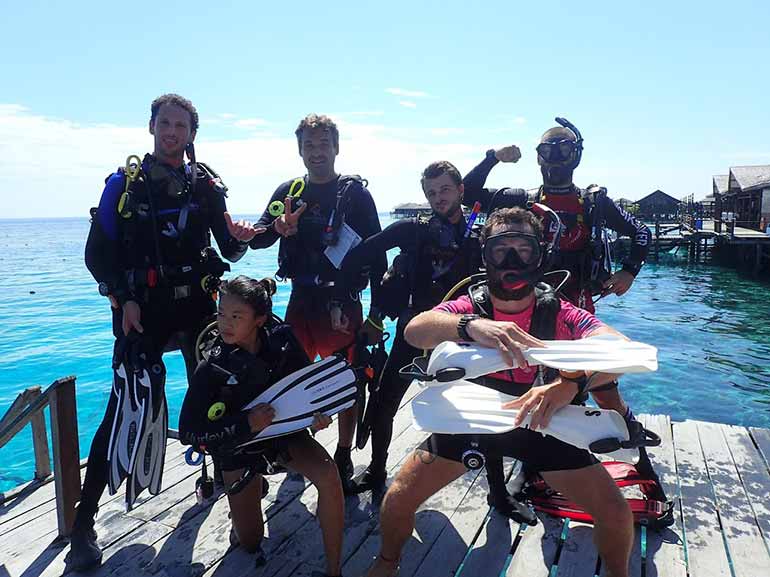
There are no right or wrong reasons for wanting to become a dive instructor. Many people have different reasons for wanting to take the course. Below are some of our personal favourites!
As a scuba diving instructor, you will spend a big part of your work-day underwater. You'll get to do what you love each day, and you'll get to introduce the incredible underwater world to others. Many of them will fall in love with the ocean just like you- and just like we did once... Watching the smile on your student's faces as they blow their first bubbles, see their first sea turtle, or come face to face with a whale shark - it's hard to explain the feeling but we can't think of much else that comes close to the same happiness!
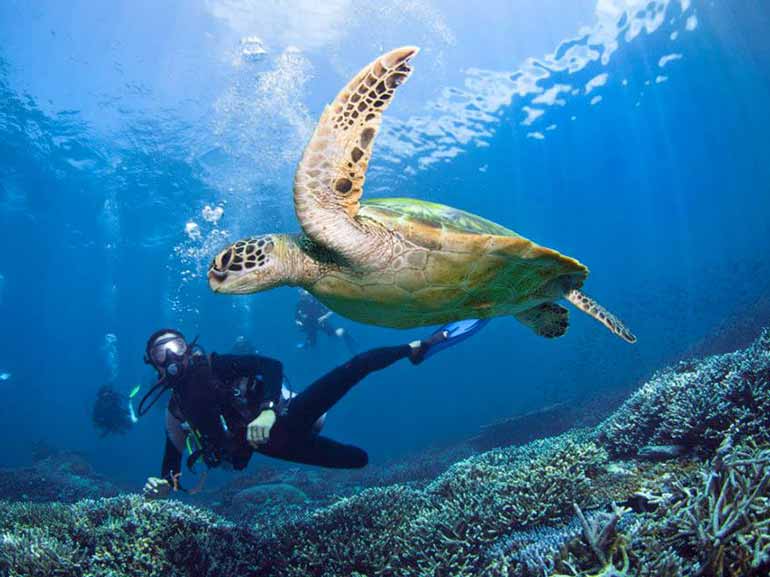
There's no denying that scuba diving can drastically change your life. As an instructor you have the perfect opportunity to inspire others to live the life they dream of, and to overcome their fears and anxieties. For some it may help them become more confident in their daily lives. Some may catch the diving bug and have their holidays forever changed. Some may be inspired to live a more environmentally friendly life and work to protect the oceans, and some may even follow in your footsteps and pursue a diving career themselves.
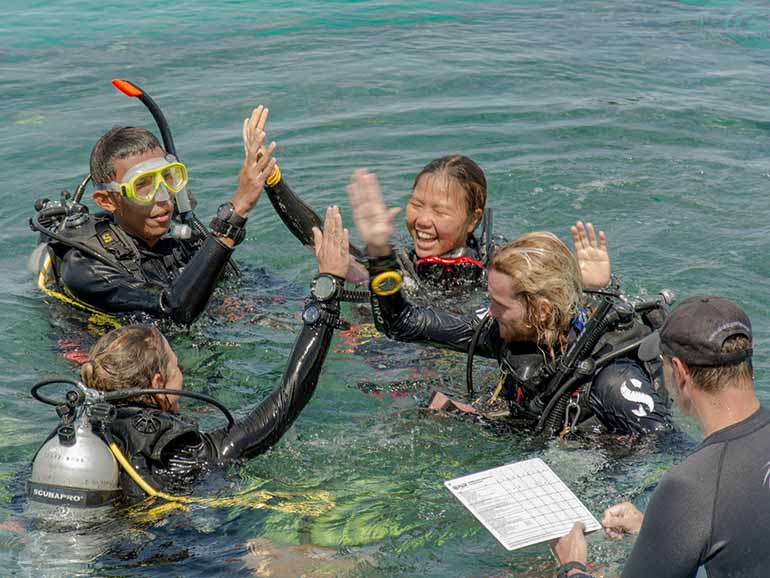
As a scuba diving instructor, you'll be able to work in places others only dream of visiting. PADI is the most recognized dive agency in the world, so wherever you prefer to dive- whether it’s on tropical reefs, mountain lakes, or fresh water rivers, the PADI instructor certification is your golden ticket to the world!
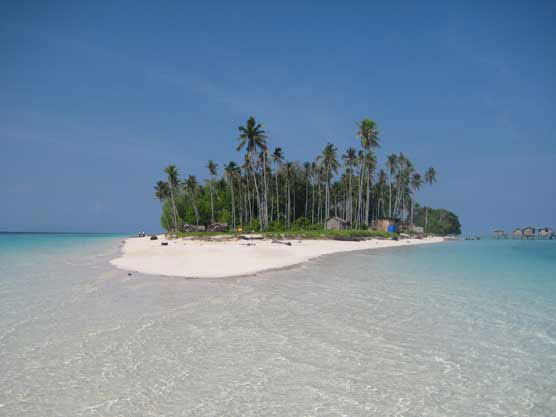
We have been running IDC's from our Mabul Beach Resort for over 12 years, and we have a 100% success rate! You'll be taught by award-winning PADI Course Director Thien X. Do, who have taught thousands of people teach other people how to dive! We also have a fantastic team of experienced in-house instructors, who are more than happy to offer guidance and advice.
At Scuba Junkie, we keep IDC classes to a maximum of 10 people - with the average size a lot smaller - meaning each student gets the personal attention they need throughout the course. We believe the IDC should do more than just teach you how to pass the course, and we are dedicated to making you a responsible dive instructor with all the means to continue a successful career afterwards.
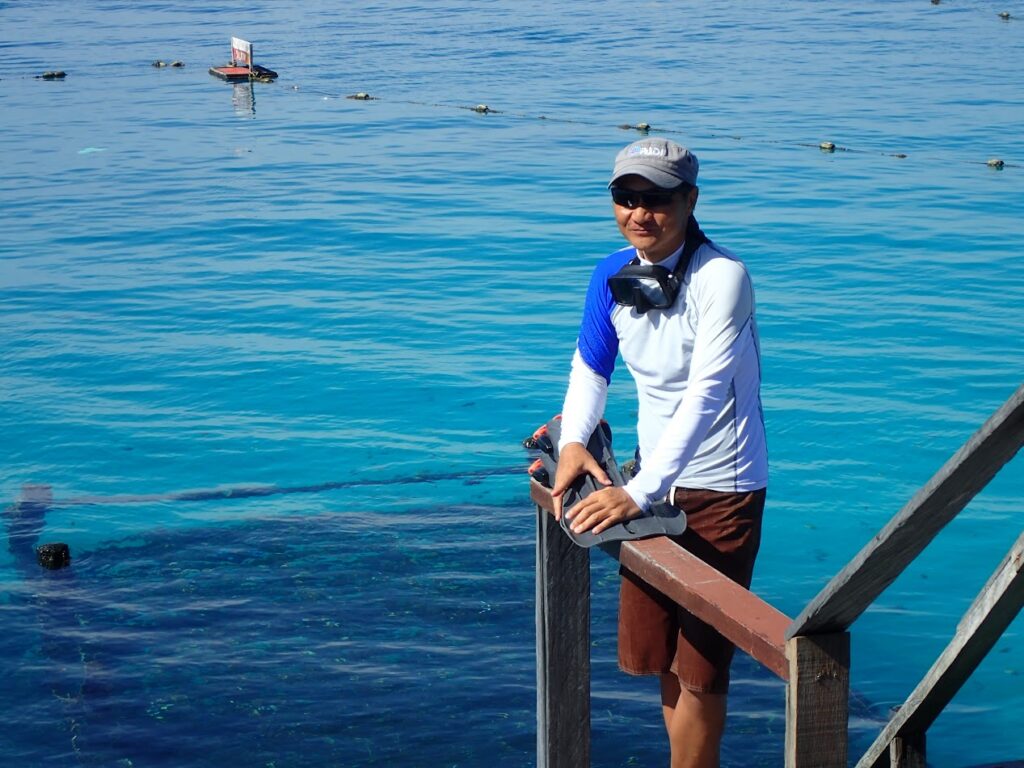
Scuba Junkie was founded by divers who are passionate about the marine environment. We believe that as divers and snorkelers, we are fortunate to be able to experience the joy and beauty of the underwater world, and that it is our responsibility to protect and conserve what we see. We run a range of different conservation projects which you can get involved with, from our on-site Mabul Turtle Hatchery, community outreach, regular beach and reef clean-ups and several yearly week-long conservation weeks.
By choosing Scuba Junkie, you will be learning how to teach diving at a dive centre who is committed to making the ocean a better place, and we want nothing more than to share our passion with you!
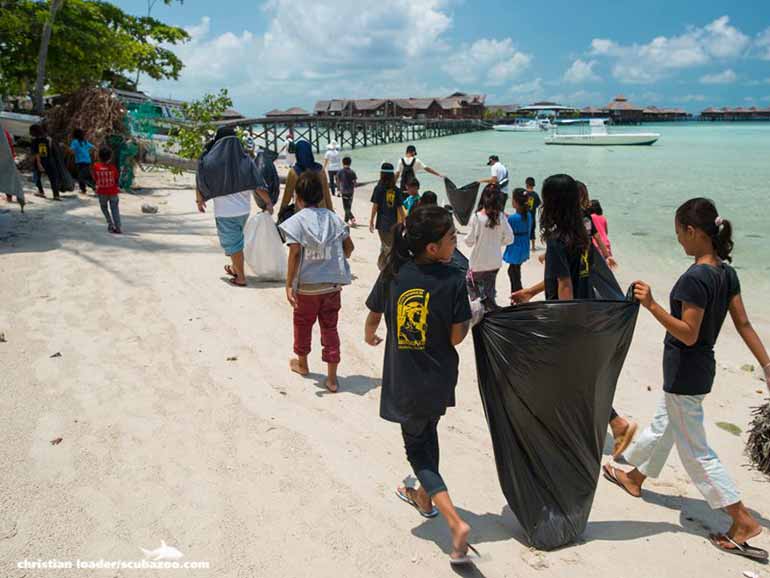
Without bias, the diving in this area is simply world-class! Just off our jetty, where you will be fine-tuning your underwater skills, you can see an incredible range of creatures – from huge green turtles, schooling reef fish, frogfish, flamboyant cuttlefish and blue-ringed octopus.
And of course, just a short boat ride away you'll find Sipadan Island, commonly voted one of the best dive sites in the world. With hammerhead sharks, schooling barracuda and jackfish tornadoes, stunning drop-offs and thousands of turtles, Sipadan is truly deserving of its' title "world's best dive site".
We offer all IDC candidates a special 25% discount on our Sipadan packages! This is a great way to get those last few dives logged before your IDC, or treat yourself to some spectacular dives after passing your IE!! We promise you won't regret it....
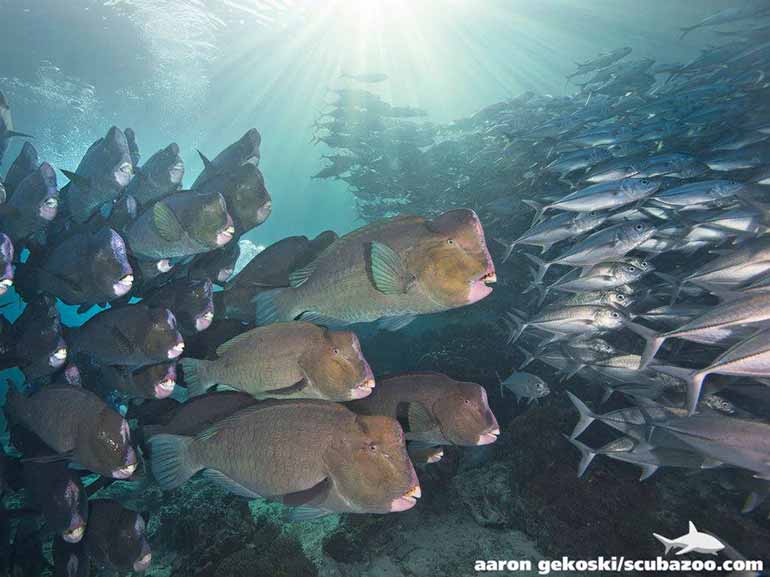
We offer both 1 month, and 3 month internships designed to give you valuable real life experience.
Once you receive your instructor rating, subject to our instructors approval, you will be able to work towards certifying your very own 25 students, have hands on experience at an award-winning dive centre and increase your employability! At Scuba Junkie, we are always on the look out for enthusiastic, dedicated dive professionals to join our family. If you excel during your internship, don’t be surprised if you are approached by our dive managers to discuss potential career options with Scuba Junkie!
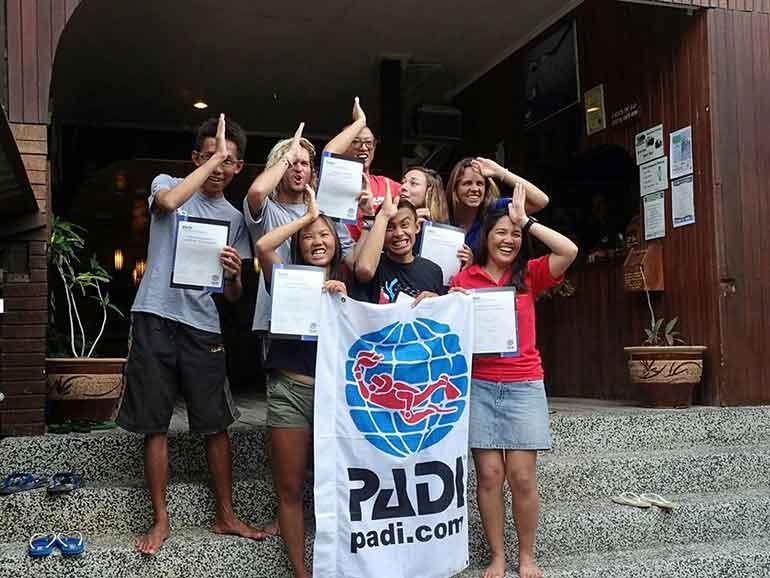
PADI Instructors are the most sought after dive professionals in the industry. As a dive instructor, you’ll be able to share your passion for the ocean and transform other people’s lives for the better, all whilst doing what you love every single day! Start a career that is unique, rewarding, lots of fun, and that allows you to work in exotic locations all over the world. If you love people, scuba diving, and want to lead an extraordinary life - become a PADI instructor with Scuba Junkie!
The moment we have been waiting for for more than 2 years is finally here! Since the first of April Malaysia has opened it's international borders and is once again welcoming travellers from all over the world! The travel will be quarantine free, and you do not need to take any pre-departure or on-arrival tests, meaning you can head straight back to your favourite dive sites (Sipadan of course...?) without delay!
In this blog post we will cover all the entry requirements you'll need to know to travel to Malaysia! The border opening just so happens to coincide with the best time of year to dive in Sipadan, so keep on reading - it is time to plan your next dive holiday!

Fully vaccinated and children aged 12 and below are exempted from pre-departure and on-arrival tests.
Partially or not vaccinated travellers must take an RT-PCR test 2 days before departure and a supervised RTK-Ag test within 24 hours of arrival. They will also have to quarantine for 5 days.
Covid-19 insurance is no longer required for all travellers entering Malaysia.

The official contact tracing app in Malaysia is called "MySejahtera". The app is used to check in at public facilities such as hotels and restaurants via a QR code, and it contains your vaccination status. You must download and activate the MySejahtera contact tracing app and fill up a pre-departure form in the app (1-5 days before departure) via the following steps:

Face masks are mandatory indoors, including public transports and taxis.
Masks are optional when outdoors but encouraged in crowded places. High risk individuals are also encouraged to wear a mask.
Physical distancing is no longer required but encouraged when not wearing a mask.
By default, Covid-19 positive cases are required to quarantine for 7 days. However, under "Test and Release", they will have an option to undergo a supervised RTK-Ag test on the 4th day. If tested negative, they may be released from quarantine.
Want to read more about our procedures on site? Check them out here.
To celebrate Malaysia opening up to the world again, we are offering all our guest some very special "welcome back discounts"!
You'll need to confirm your booking before the 30th June to secure the discount, and come and dive with us before 31 Dec 2022. Find more info about the special package prices here. It's time to get your Sipadan fix! We can’t wait to welcome you back to dive with us again soon!

By Borneo from Below presenter, Bertie
Let’s not sugar coat it: Semporna isn’t the most beautiful of towns. Rough around the edges, maybe. Hot, definitely. Congested, certainly. But Paris it ain’t. Which makes it all the more surprising when you consider this region is home to some of the top dive spots on the planet.
I was lucky enough to spend 2015 filming the web series Borneo from Below in conjunction with our good friends at Scuba Junkie. During this period we went in search of the area’s most colourful coral reefs, mesmerising macro, pleasing pelagic life and sumptuous schools of fish.
From the shrimpiest of shrimp to a non-stop turtle highway, paradise islands to mucky sandbanks, this region has a little something for everyone. Here’s a countdown to my 5 favourite dive sites around Semporna.
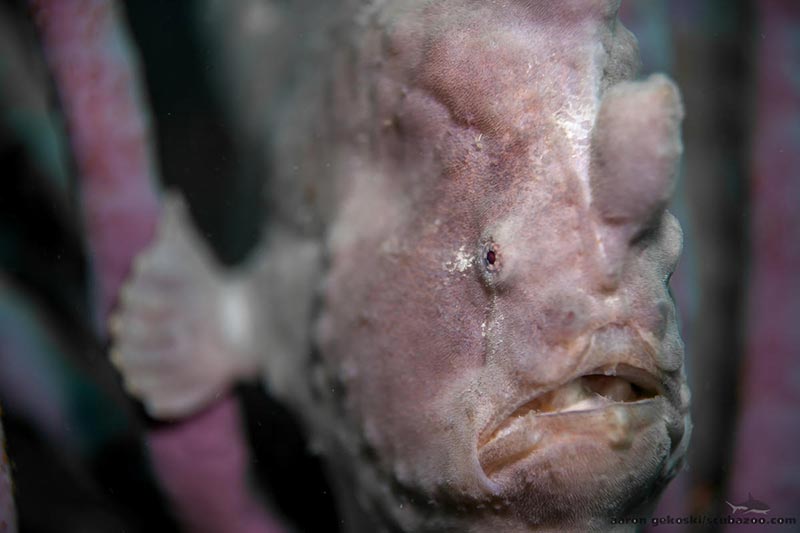
What do you get if you cross your classic paradise island, with a small community of sea gypsies and a heap of frogfish? You get Sibuan, a tiny dollop of loveliness just a short hop, skip and a dive away from Scuba Junkie’s base in Semporna.
Known locally as ‘Battleship Island’ due to its distinct shape, above the waves Sibuan is all palm trees and white sandy beaches, along with a small scattering of huts built by the Bajau Laut. These ‘sea gypsies’ are known for their incredible freediving skills and their children are often found frolicking in the shallows, offering great photo opportunities.
Underwater, Sibuan offers both muck diving and great reefs – most notably at dive site Hawksbill Highway; a blanket of cabbage coral that provides the perfect ampitheatre for turtles and cuttlefish. Plenty of frogfish can be found wallowing in the muck, as well as the usual suspects: snake eels, seahorses, spiny devilfish and more.

Whilst Sipadan grabs most of the diving headlines around here, the diving right off Scuba Junkie’s jetty in Mabul is surprisingly fishy. Dive site Awas plays host to dozens of green turtles - some the largest I’ve ever encountered. On artificial reef structures they endure divers with good grace, whilst wrasse pluck parasites off them.
On and around these structures are broadclub cuttlefish the size of rugby balls, frogfish, schools of snapper, ghost pipefish, mantis shrimp and flamboyant cuttlefish. Easy diving, fabulously fishy - and all located no more than a couple of minutes swim from the jetty: Not. Too. Shabby.
You can see Awas in the following Borneo from Below episode.
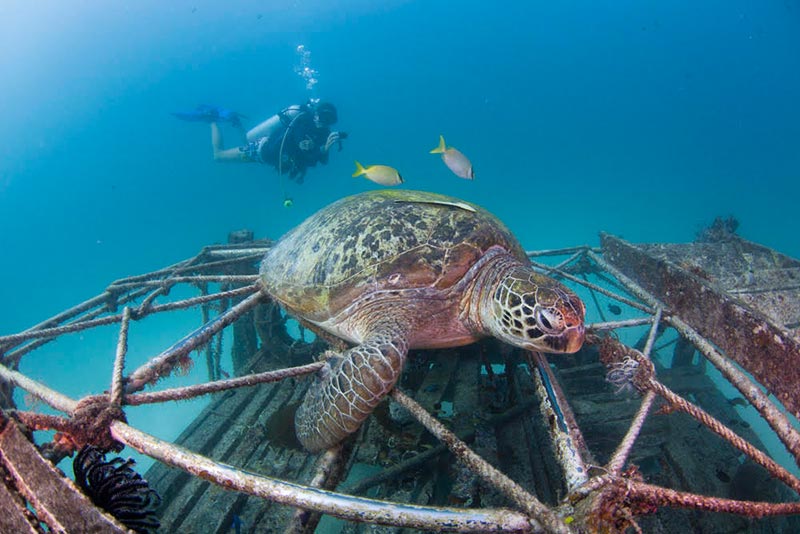
Kapalai, which lies a short 15-minute boat ride from Mabul, is a sandbar with a luxury hotel plonked on top. Kapalai is all about the macro. At around 20m are a series of artificial structures covered in coral and some of the coolest nudibranchs you will ever lay eyes on. One of Scuba Junkie’s DM’s, Nas, even found one with two heads – a world first!
The sloping reef is also one of the best places to spot blue-ringed octopus in the entire region. If you’re lucky you may even catch a glimpse of the resident giant moray eel, Elvis. Elvis’ head is as big as yours.
Elsewhere keep an eye out for waspfish, frogfish, Indian walkmen, leaffish, stonefish and more funky critters. As the sun sets over this delightful sandbar, divers can even see manadarinfish performing their famous ‘love dance’: a mating ritual and one of the most mesmerising experiences a diver will ever have, anywhere.
View the two-headed nudibranch here.
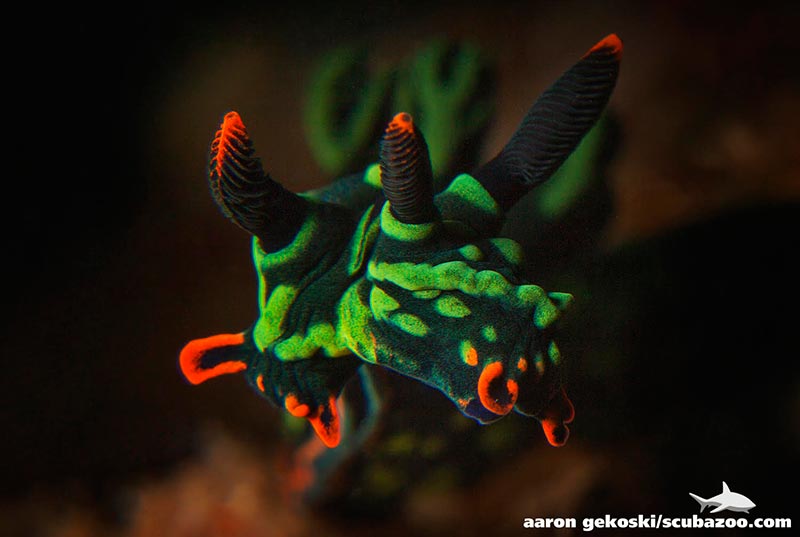
If you enjoy small, jaw-droppingly stunning, seldom-visited sites with water the colour of Frank Sinatra’s eyes, then Mantabuan is the place to dive. Along with its impossibly pretty exterior, this volcanically-formed island is renowned for its black coral: a rare species that’s worth more than gold on the black market. Found at around 25m, these swaying bushes are actually white in colour – the term ‘black’ comes from their skeleton.
Whilst it might not have the variety of fish life that Sibuan does, Joseph has thrown his technioloured dreamcoat over these reefs. Within the coral folds, flaps and fingers lurk plenty of unusual nudibraches. Don’t forget to keep an eye on the blue - in visibility often in excess of 20m - for schools of barracuda and snapper.

Formed as a result of living corals growing on top of an extinct volcano cone, Sipadan was famously referred to as “an untouched piece of art” by Jacques Cousteau. Whilst our oceans are plundered at an alarming rate, rendering once-famous dive destinations fishless and broken, Sipadan has changed little in the 30 years since Cousteau made these remarks.
This, in part, is due to protection offered by the Malaysian authorities who have banned fishing around the island and only hand out 120 dive permits a day. Because of this, divers must book their trip here well in advance.
A shoe-in on lists dedicated to the world’s top dive spots, divers travel from all over to spend time Sipadan’s resident schools of barracuda, bumphead parrotfish, jackfish and sharks, along with giant turtle populations. In diving terms, it doesn’t get much better.
What’s it like to spend a day diving at Sipadan? See here!

To keep up with SZtv’s Borneo from Below, please like: https://www.facebook.com/Scubazoo/
And subscribe to their YouTube channel: https://www.youtube.com/user/ScubazooVideo
Have you noticed that the standard dive advertising, always has beautiful people with perfect bodies. They are 20 something, without an inch of fat on those toned, washboard tummies. The simple truth, is we are not all made that way. There are some people, that can learn to dive, and instantly succeed in staying down for 60 minutes. I was not one of them....
My first dives were between 30-35 minutes, and this continued for many years. The problem being, that when you only get to dive 1-2 weeks a year, it’s hard to improve. What you learn in that time, is countered by the year gap until your next underwater adventure. Also, I wasn’t twenty something, and I certainly didn’t have a washboard tummy!
This was enhanced, by no one actually telling me the secrets. You will see countless posts on breathing techniques, so I won’t bore you with them. These are simple guidelines to getting a longer dive.
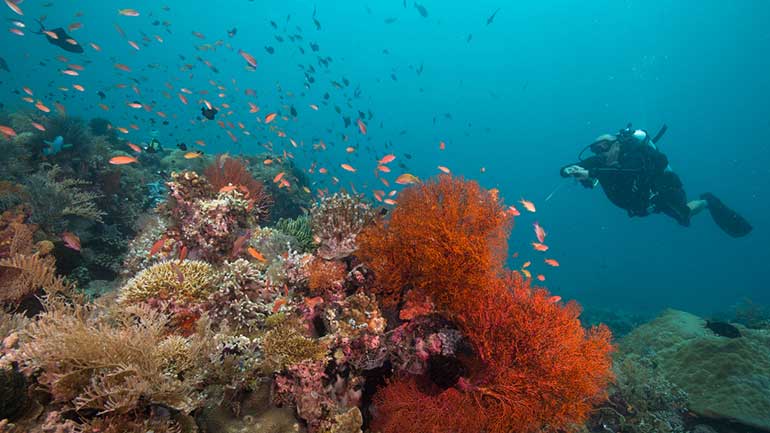
It is so important to be relaxed. As a diver, you want to use as little energy as possible. This obviously increases with more experience. It does help if you are comfortable in the water. Buying your own equipment assists in that. Every dive feels the same. You don’t have to get familiar with a new set up. The same dive buddy or diving with a divemaster you trust, all helps to relieve stress.
When you learn to dive, you are taught the flutter kick. It’s standard, and easy to do. However, it does utilise the biggest muscle groups in the body. The quads, hamstrings and buttocks. These muscles need a lot of oxygen to perform. In turn making you heavier on air. You never see a professional divemaster, or instructor using this kick. We use the frog kick. This uses the smaller muscles on the side of your legs, and calves. Smaller muscle group.... less oxygen needed.
Obviously the deeper you go, the more air you use. But you can help in other ways. Try and anticipate what your divemaster is trying to show you. Be in a position to respond without major movement. It really helps to be behind your divemaster by a few metres, that way you only have to make minor adjustments in position to see what they are trying to show you.
Use the topography to assist you. Look at the terrain a head. If you are swimming against the current, look for obstructions a head. Try and get in their slipstream. The closer you are to the reef, or bottom, the less the current. Now I’m not saying you should endanger the reefs and corals. But as your experience improves, the closer you can get, the less energy you use.
Now don’t attempt all this at once. Don’t expect to turn your dive times around overnight. But do practice. I recommend ten minutes a dive. Then enjoy the rest of your time. Recreational diving is about enjoyment , we do it for fun. However it is healthy to try to continually improve. This leads to more relaxed dives, which leads to longer dives.
Happy Bubbles
Divemaster Simon (bigger than your average divemaster!)
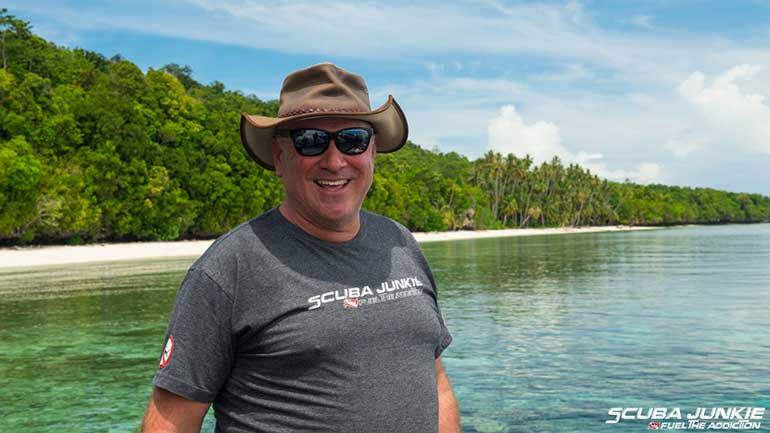
Are you missing the clear, blue waters and marine life of Sabah? Good news! Starting from the first of November, Sabah will be open for interstate travel. After many months of state borders being closed, it will now be possible to enter Sabah again for diving, no matter where in Malaysia you are travelling from! We are very excited to open up for out-of-state visitors again, and to welcome you all back to the incredible dive sites of Mabul, Kapalai and Sipadan!
We are offering some special opening promotions with awesome discount to help you get back in the water, and if you are worried that the situation may change again, we’ve got you covered! All packages are covered by our Worry-Free Guarantee, and you will be able to change your dates with no extra fee if needed.

Starting from the first of November, you will be able to enter Sabah from any other Malaysian state, without needing any special permission to travel and without the need to quarantine upon arrival. The rules that apply are the following:
Book a Sipadan package for best value! Sipadan is considered one of the best dive sites in the world, and now would be a great time to visit – before the crowds come back! Packages include accommodation at our Mabul beach Resort, diving at Mabul, Kapalai and Sipadan, Sipadan permit fee, equipment rental, boat transfers to/from Mabul at specified times, meals, tea, coffee & water.
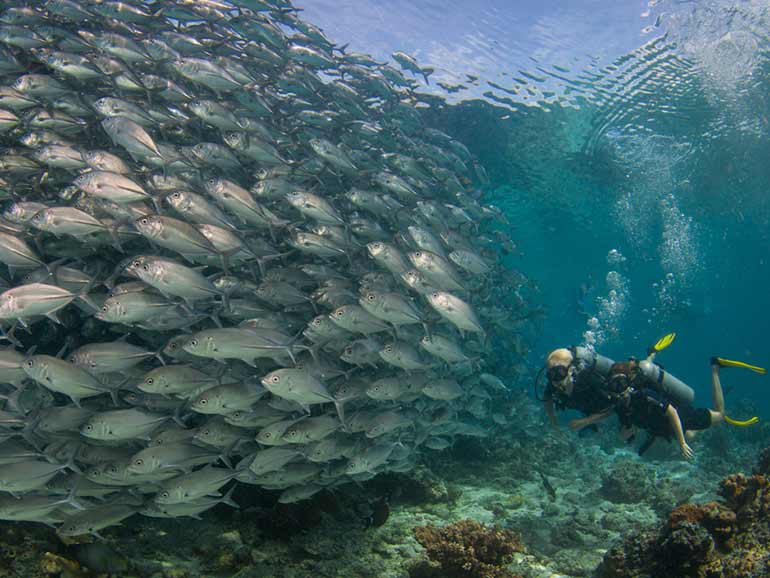
Been bored during lockdown? Now is the perfect time to try something new! If you are new to diving, check out our Discover Scuba Program and Open Water Course.
If you are already a diver, consider signing up for the Advanced Open Water or Rescue. Or why not go all in and become a PADI Divemaster? We offer all PADI dive courses as well as some Specialties.
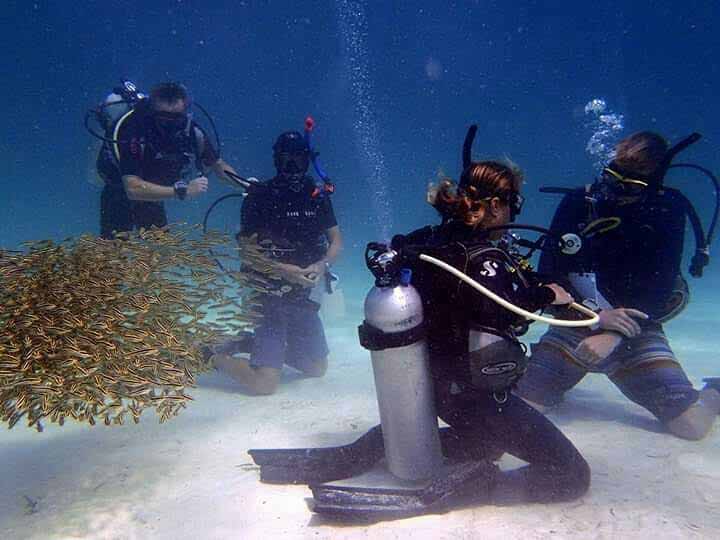
You don’t have to be a diver to visit us. Snorkelers can also enjoy the beauty of the underwater world and the unique marine life which can be found in these waters. You’ll be able to swim with huge sea turtles, colourful schools of fish and beautiful coral reefs. Check out our non-diver packages here.

We have thorough Covid-19 safety measures in place to keep you, our staff and the local community safe, and to ensure that you still have an amazing trip during these unusual times. The key parts of our measures are:
We urge you to follow all the outlined safety measures. Our staff have been trained to follow and carry out these measures to make sure that your diving trip is as incredible as you imagined – even in these extraordinary times!
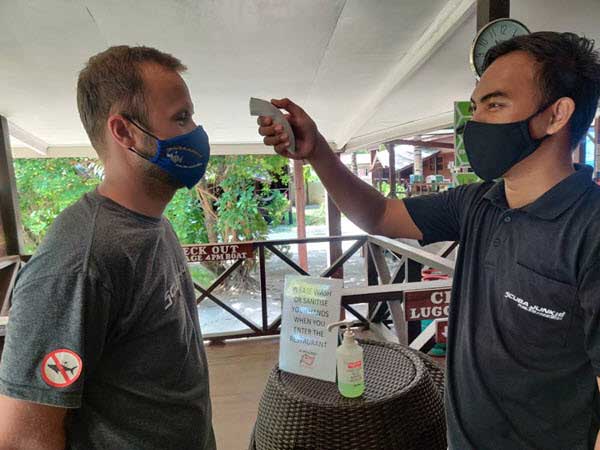
We can’t wait to welcome you back to our resort, and to take you diving on the amazing reefs in this area. We’ve been missing the water during these crazy times, and we bet you have too! Now is the best time to book your diving trip – great weather, less crowded and you can get some great discount on your booking! Contact us today via the form below to find out about our special re-opening rates.
Let’s go diving!
Many divers and snorkelers who’ve spent time diving in South East Asia will have a story or two to tell about the infamous titan triggerfish… In mating season, triggerfish get extremely territorial and will viciously defend their nesting site against intruders – including oblivious divers and snorkelers!
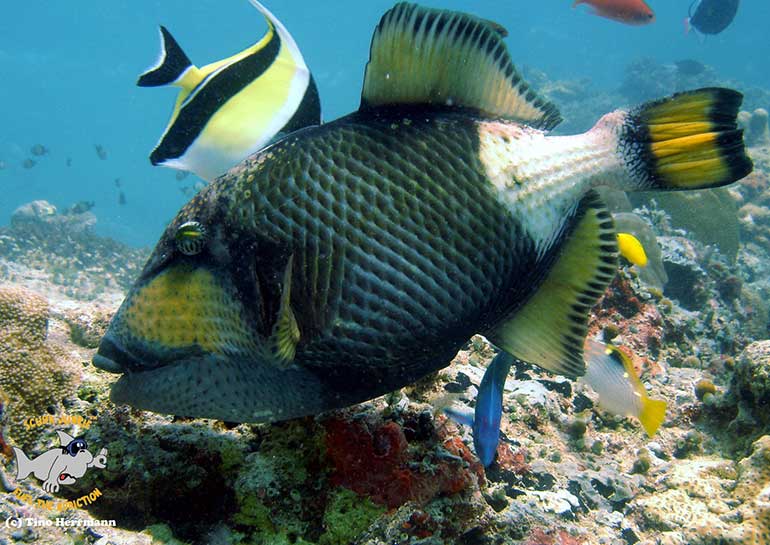
Although they are an interesting and beautiful looking fish - the titan triggerfish has a notorious reputation amongst divers. They are fairly docile for the most part of the year, but they can get very feisty in nesting season! Whilst unable to cause any serious or life-threatening injury to humans, they do have large, sharp teeth designed to crunch corals, and they pack a powerful bite best avoided.
So, how come they are so aggressive? It is widely known that titan triggerfish are extremely territorial by nature, especially if you happen to encounter them in nesting season. And whilst most of them are merely looking to protect their nest – some seem to just enjoy snapping at divers fins just for the fun of it.. Luckily, there are some clear signs indicating that trouble is coming your way!
Their first dorsal fin has three spines, which can be locked into an “erect” position. The first spine is locked in place by erection of the second spine and can only be unlocked by depressing the second “trigger spine”. When threatened, they will use this to wedge themselves into coral crevasses, making them virtually immovable.
The spine is usually only visible if this triggerfish is feeling threatened or anxious and this serves as a clear warning for divers to start swimming the other way…

It's said that the eyes are the window to the soul, and when you start getting the old evil eye from a titans’ independently rotating eyeballs - it’s best to keep your distance! Especially if they’re moving jerkily or if you spot them rolling onto their side whilst giving you the stare.

If you’ve unknowingly happened to bump into a titan triggerfish, intent on eating various pieces of your dive equipment, don’t panic! We promise there is a way out!
First of all, turn your fins towards the offender and use it as a barrier between you and the fish! Oftentimes the triggerfish will not actually bite you, but is simply trying to escort you out of their zone. However, if they are going to take a nibble, much better it’s through your fins than through your body.
Their territory is shaped as an upside down cone from where the eggs are hiding, so swimming upwards will not help you escape the nesting zone – we’ve seen triggerfish following divers all the way up to the surface. Horizontal is the way to go! Keep your eyes on them the whole time, whilst you make your swift horizontal escape.
Once you’ve made it out of the zone, they’ll stop chasing you. They’ll head back to their nest and you’ll head home with some adrenalin-filled stories to share with your friends and family!

Whilst the triggers’ nasty reputation is somewhat well-deserved, it’s important to remember that they are (usually…) just looking to defend their young ones from what they think are intruders to their territory.
Divers who have experienced a nesting triggerfish before may get anxious seeing them underwater and instinctually shy away. This is understandable in nesting season, but for most part of the year, not necessary!
Usually your dive guide will inform you in advance if you’re heading to a dive site which may have nesting triggerfish present. They will know where potential nesting grounds are and do their best to avoid those areas. Follow their lead and you should be fine! And just in case you encounter a feisty looking triggerfish, you now know the signs of a triggerfish in distress, and how to make a safe escape!
The eternal question. For the uninitiated, to do a "blue dive", is to leave the reef/wall and swim out into to open sea. For a Sipadan divemaster, there are many pros and cons in making this choice.

Sipadan can produce very strong currents. These currents are not confined to the wall. However, by the wall, you do have some reference as to how strong and what direction they are going. In the blue, you lose this perspective. In essence, it increases the chance of not finding the wall again when you try to return.
At Sipadan, this is very important. The coral is so beautiful, and you will inevitably see sharks, turtles and numerous reef fish species in this area. The financial cost of diving Sipadan, which only has limited permits per day, is much higher than your average dive. People travel from all parts of the world to dive this world top ten destination. To spend the whole dive in blue water, and not see any fish or marine creatures is, well, unthinkable. So why would we even consider it?
The reason we would take this gamble is the chances of seeing something truly spectacular. Most of the hammerhead shark encounters that we experience are in the blue. That doesn’t mean that you can’t see them by the wall, but you do have a much greater chance in the open water. In fact, many of the sightings by the wall follow quickly on from having returned from a blue dive. Possibly because the divers have attracted the sharks by their presence. Also, it provides you with a chance to see the the holy grail at Sipadan, a big school of hammerheads. This phenomenon has become increasingly rare, as shark numbers have declined rapidly due to over fishing.
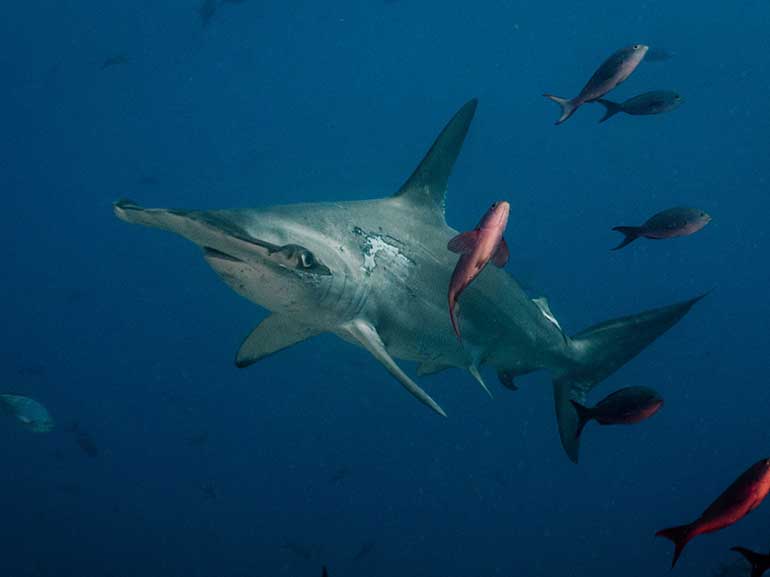
Of course, hammerheads are not the only attraction out there. We have had sightings of other sharks and rays. Especially devil rays, between October and April each year.
There is also the surreal feeling of diving with no reference point. Likened to diving in space. This can be a disconcerting feeling to a newer diver. Without a reference point, a divers brain can become anxious, nervous or have a feeling like vertigo. To the more experienced diver, it’s a feeling of freedom, expectation and excitement. You either love it, or hate it. The secret for the newer diver, is to focus on something strong, and reliable in front of you. Your dive guide?! We have our computers and compasses to give us our reference.
Now we do not see something in the blue on every trip, far from it. In fact, I would say maybe as few encounters as one in ten. However, if you are lucky enough to have one of those special encounter, it raises the bar considerably. It’s the difference between “that was a great days diving” to “oh my god, that was the best dive of my life”!
Happy Bubbles!
By Divemaster Simon

If you thought diving was all about crystal clear visibility, stunning coral reefs, schooling fish, sharks, rays, and turtles – you’d be right! But only partly. Today we’ll introduce you into a different type of diving, called “muck diving”.
Whilst the name doesn’t sound very enticing, muck diving can be one of the most rewarding forms of diving. It refers to diving in muddy conditions on sandy or silty bottom dive sites, in the search for small, bizarre-looking creatures. In comparison to colourful coral reef dives, a muck diving site may look dull or empty at first sight, but we can ensure you that this is NOT the case! There is such a diversity of marine life to be found on these dive sites, and they are anything but boring!
Many of the critters you’ll see have developed some impressive skills and features to help them live in the muck. You’ll get to see both extraordinary camouflage and mimicry skills, as well as flashes of vivid colours used to threaten potential predators. Muck diving may be a completely different diving experience than what you are used to, and you’ll be challenged to really slow down and zoom in!
You can expect to see some incredibly weird and wonderful creatures hiding in the muck, many of which are super rare and very well camouflaged. Your dives will turn in to treasure hunts, and the treasures to be found around Mabul are well worth the effort!
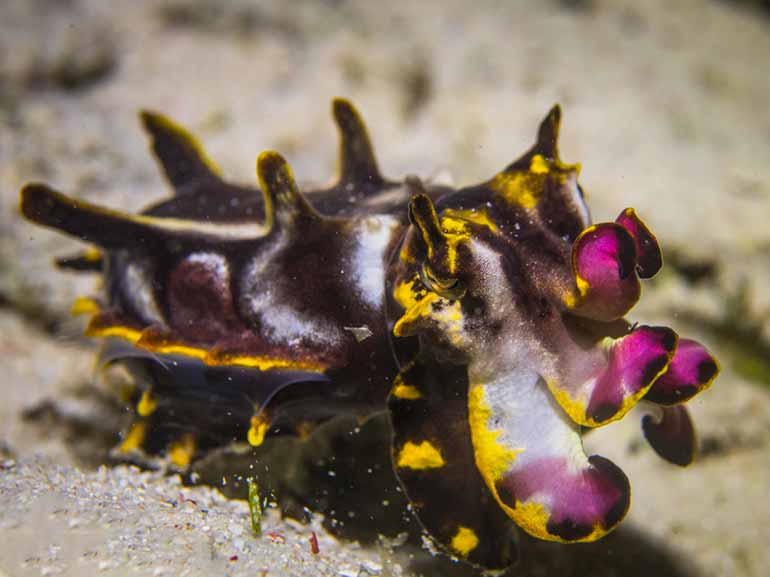
Mabul Island is one of the richest dive spots in the world for rare small critters, with diversity rivalling muck diving meccas such as Indonesia’s Lembeh and Philippine’s’ Anilao.
Flamboyant cuttlefish, blue-ringed octopus, stargazers, seahorses, all types of frogfish and ghost pipefishes are just a few of the crazy critters to be found around Mabul! The dive sites around Mabul range from sloping coral reefs, to sandy slopes, seagrass beds, jetty dives, artificial reefs and everything in between.
Together with its proximity to world-famous Sipadan Island, Mabul certainly offers one of the best well-rounded dive holidays you can find in Asia, if not the world!
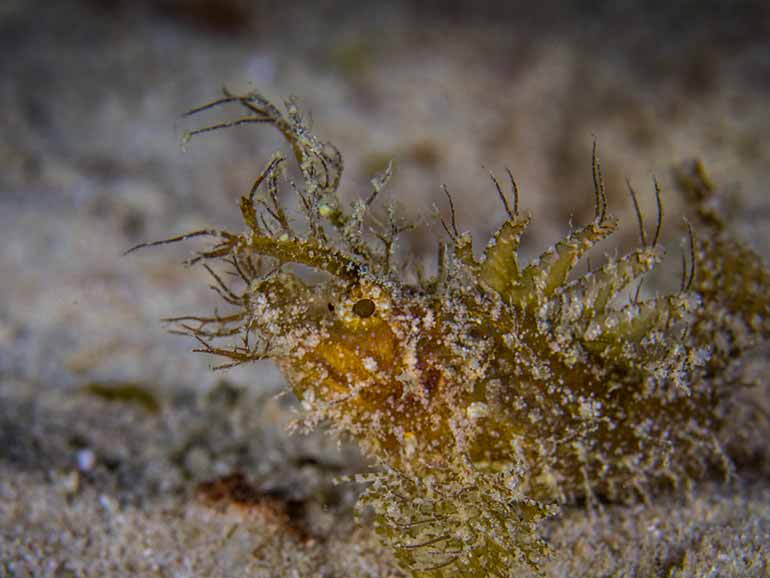
Cephalopods are some of our favourite critters to search for, and lucky for us, there’s no shortage of them around Mabul! The flashing colours of the elusive flamboyant cuttlefish and blue-ringed octopus will leave you in awe, scrambling for your camera. With a bit of luck you may spot the elusive mimic octopus, a true master of disguise known for its ability to mimic other types of marine life. If you decide to brave the dark and embark on a night dive you’ll be in for a treat with regular appearances of bobtail squid, Papuan cuttlefish, coconut octopus and two-tone pygmy squid amongst others!

There are approximately 50 species of frogfish out there, many which can be found in this area. They may not win any awards for their good looks, but oh how much we love them still! Frogfish are masters of camouflage and many can change their colour to match their surroundings. They spend most of their time moving as little as possible, blending in with the environment, but make no mistake – when they do move, they are FAST! Frogfish have one of the fastest attacks in the animal kingdom, it can be as quick as just a few milliseconds! Blink and you’ll miss it!
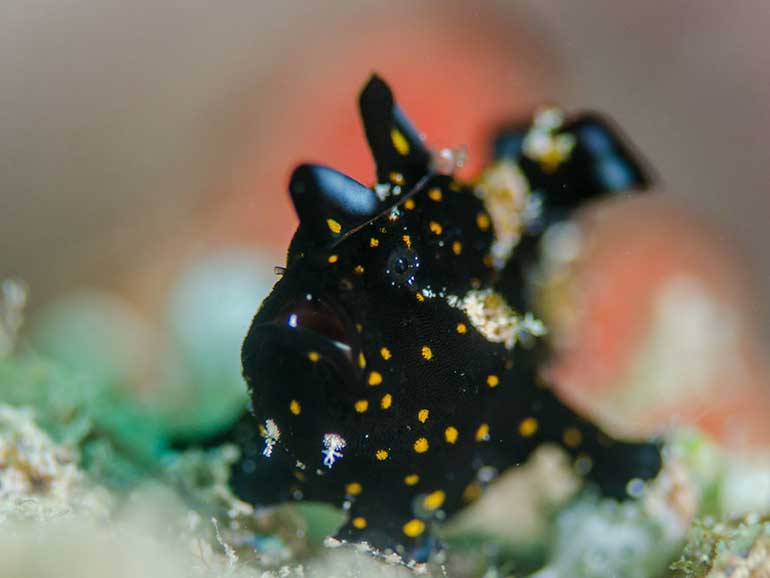
The list of Mabul’s crustaceans is loooong and it would be near impossible to list them all out, but some of our favourites include the harlequin shrimp, orangutan crab, peacock mantis shrimp, tiger shrimp, candy crab, hairy squat lobster, zebra crab, hairy shrimp, spider crab, coleman shrimp, bumblebee shrimp and skeleton shrimp. Phew! We could go on and on, the list is endless!
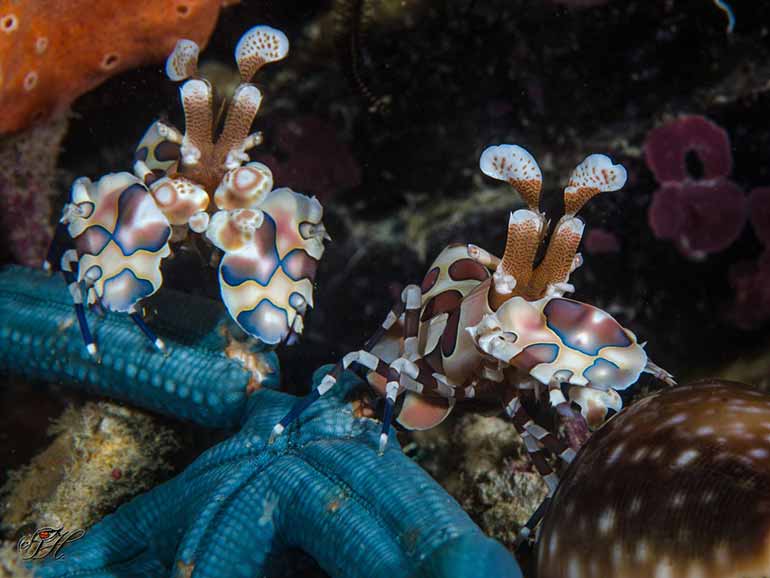
Hunting for nudibranchs is highly addictive… It could be a sport of its own, and Mabul would definitely one of the best places in the world to do it! It’s not uncommon to see over 20 different species in just one dive, all different in shape, size and colour. Nudibranchs get their bright colours from the food that they eat, and these may be used either for camouflage or to warn predators that they are poisonous! Nudis make for fantastic photograph subjects as they are generally slow moving, with stunning colours on display.
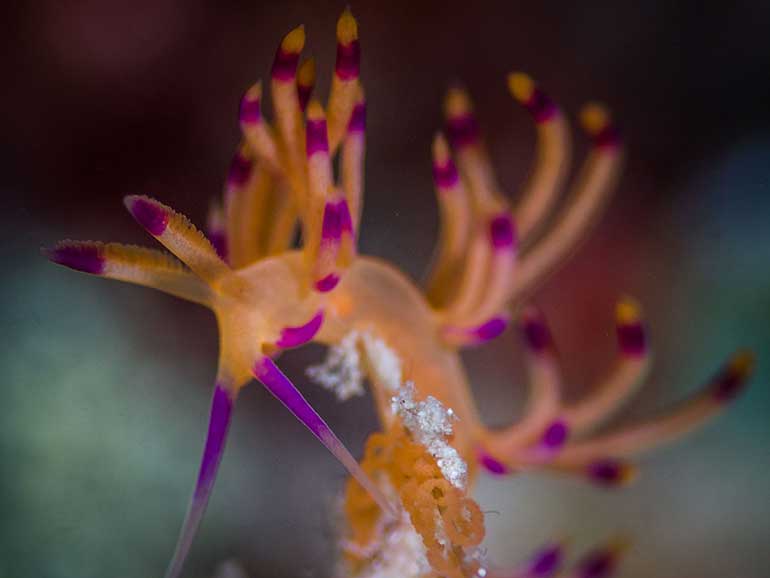
If there was ever a competition for the worlds pretties fish, the mandarin fish would definitely rank pretty high, with its’ ornate patters and stunning colours! At sunset they put on a show to be remembered for anyone lucky enough to see it. They perform one of nature’s most incredible mating rituals, or “mating dance”. To the non-initiated it may seem like strange behavior to travel across the world just to watch two tiny fish doing X-rated performances, but we promise it is a sensational experience and perfectly normal diving behavior… 😉

From pygmy seahorses, pipefish, ghost pipefish and pipe horses there’s no lack of these guys around Mabul! Look in and around feather stars for the ornate ghost pipefish, or on the sandy seagrass bed for robust and slender ghost pipefish. Pygmy seahorses hide amongst the polyps of same coloured gorgonian fans. There’s an abundance of stick pipefish, banded pipefish, reeftop pipefish and winged pipefish – and with a bit of luck you may find a velvet ghost pipefish or a halimeda ghost pipefish too!

In diving terms, if it’s hairy it’s AWESOME! Yep that’s right, and the more hair the better! Hairy octopus, hairy frogfish, hairy shrimp, hairy squat lobsters. All of the above are rare and highly sought after creatures amongst divers and many would travel great distances to get a glimpse of a hairy octopus, or to get that perfect shot of a hairy frogfish.

Located right in front of the Scuba Junkie jetty, our house reef is one of THE best dive sites around Mabul. If you ask our staff members about their favourite dive sites, many place AWAS very high on their list! An excellent sandy slope dive site known especially for its regular encounters with the elusive flamboyant cuttlefish. Other gems to look out for are different types of ghost pipefish, frogfish, fingered dragonets, flying gurnards, snake eels, nudibranchs and mandarin fish! 60 minutes just doesn’t seem like enough time to explore everything AWAS has to offer, and in fact many divers want to repeat it more than once!

Including both a sandy slope with a few sunken boats, as well as a shallow sloping reef this is a great dive site for those who wish to have a bit of a mix of everything. You’ll see plenty of the typical muck diving critters along the sandy bottom, as well as a healthy amount of fish life attracted by the wrecks. You can then finish off the dive and perform your safety stop gently drifting along the coral reef. A healthy mix of all good things! This is a great dive site in particular to spot the ornate ghost pipefish, and different types of frogfish!

Just around the corner from our Mabul Beach Resort is the dive site Artificial Reef, a large sandy area with lots of man-made structures. It’s an awesome place to really slow down and zoom in. You’ll find an abundance of different crustaceans, cephalopods and pipefish. Chances are high you’ll see a frogfish or two, and there are colourful nudibranchs dotted along each and every structure.

Whilst the rig may be a bit of an eye sore on the horizon, the marine life you’ll find underneath is spectacular. It’s a playground of reef and sandy patches, artificial structures and some stretches of rubble. It might not be the prettiest dive site, but we can ensure that you could fill more than just the one page of your log book after this dive. Look out for pygmy seahorses, blue-ringed octopus and frogfish smaller than your fingernail!
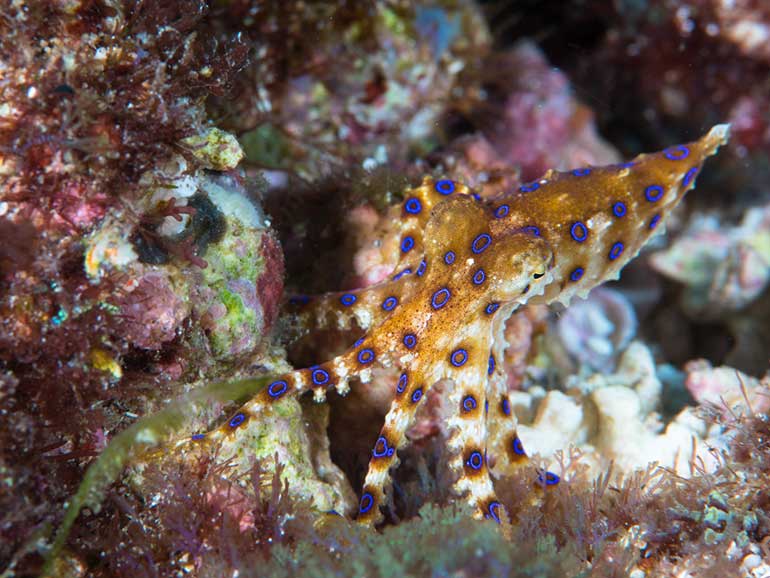
In general, the slower you go – the better! A muck dive is not the time and place to rush, and when you take it slow you’ll see so much more marine life. Be patient and you will be rewarded! Many of the critters you are searching for are either quite small OR very camouflaged – if you speed across the dive site you will definitely miss a lot of cool stuff!
Diving over a sandy or silty bottom requires good buoyancy control! Keeping your hands, fins, and equipment off the bottom is essential to avoid stirring up silt from the bottom - reducing the visibility. You’ll also want to avoid disturbing the environment and the animals hiding in it.
An experienced dive guide can make or break your dive! A good dive guide will know the local environment, the best places to find certain critters, and sometimes it seems they can conjure amazing critters out of seemingly nowhere!
This is a good tip for diving in general, but especially so for muck diving! Many of the sought after critters live in very specific environments and habitats. A certain animal may prefer a special habitat, and some you can only find on just ONE type of coral! Knowing where to look is imperative!
Again this can be applied to all types of diving. Respect the marine life and you’ll find you have longer lasting and better underwater encounters. When you find a critter, try your best to keep a respectful distance as to not spook or disturb them. Never touch or move critters for the sake of a better photograph!
At first glance, you may wonder what all the fuss is about when you descend on a seemingly “empty” dive site, with little to no coral around – but give it a chance and you’ll be pleasantly surprised! You’ll likely spend most of the dive with your nose just inches from the ground, combing through the dive site, and you’ll be surprised by how just how many critters you can cross off your wish list!

Hopefully we’ve given you a bit of an insight to this different style of diving and why muck diving is so incredible. Diving doesn’t have to be all about coral reefs and big species! Give it a go on your next dive holiday, and before you know it you might find yourself becoming a muck-diving addict!
What better place to discover it than Mabul Island, a world renowned muck diving Mecca? Check out our dive packages here, the best way to explore Sipadan, Mabul and the surrounding islands!
Sipadan Island is at the top of many divers bucket lists. Year after year it is voted one of the best diving spots in the whole world... In this blog post we are going to cover everything you’ll need to know about diving in Sipadan, so buckle up and enjoy the read!
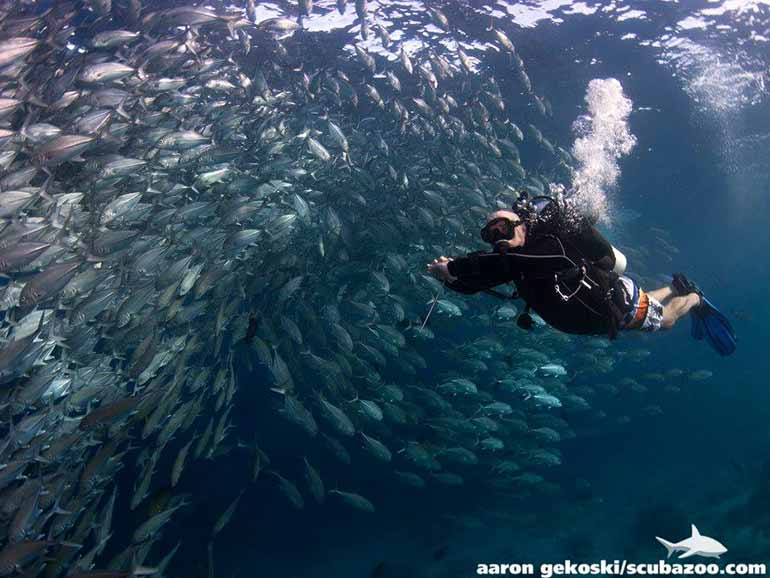
If you’re a scuba diver reading this blog it’s likely that this is not the first time you’ve heard about Sipadan. Every year, the island frequents the list of the top 10 world’s best dive sites, and it’s not hard to see why! There are few places in the world that offers such rich biodiversity. Sharks, turtles, swirling barracuda tornadoes, enormous schools of trevally and bustling reefs full of reef fish are just a few of the highlights when diving at Sipadan.
Do you like sharks? White-tip and grey reef sharks, hammerheads, leopard sharks, threshers and even whale sharks are some of the species you may encounter diving here. It’s also a real turtle heaven, with both green turtles and the smaller hawksbills virtually guaranteed. It’s not uncommon to see more than 20 turtles in just one dive!
Do you want more? How about the famous barracuda tornado, the resident school of jackfish, or the rampaging herd of bumphead parrotfish? Still want more? There’s also a wealth of macro life - octopus, leaf scorpion fish, lobsters and nudibranchs are common finds here amongst many others. Of course these require you to peel your eyes off the blue and the big fish action going on around you!
There is simply no such thing as a bad day at Sipadan, and we truly believe that this is one of, if not THE best dive spot in the entire world!

Located in the Celebes Sea, Sipadan Island was formed as corals grew on top of an extinct volcano over thousands and thousands of years. Sipadan is the only volcanic island in Malaysia to breach the surface, and today the island drops straight to the sea floor over 2,000 meters deep!
Sipadan is located in the middle of the coral triangle, the richest marine habitat in the entire world. This area sports over 600 different coral species and nearly 3,000 fish species. It is safe to say that this is one of the most biodiverse marine areas on the entire planet, and you’ll probably need to bring some extra pages for your log book to note down all the different marine life you’ve seen on your dives!
The Island is a national park under the protection of Sabah Parks, and is a complete no-fishing zone. You will not find any fishermen here. From commercial ships to small one-man boats, fishing is not allowed within a 500m radius of Sipadan. As a result, you will see a staggering amount of fish life whilst diving here, indeed sometimes it can be hard to keep track of your dive buddies due to the sheer amount of fish!
The oceanic currents and the depth of the island makes Sipadan a converging point for pelagic marine life. The whole marine food chain in its entirety can be found here! The beauty of Sipadan lies in its diversity, from tiny nudibranchs and colourful reef fish to whales, sharks and turtles – it truly holds the spot as one of the most unique dive spots in the world!
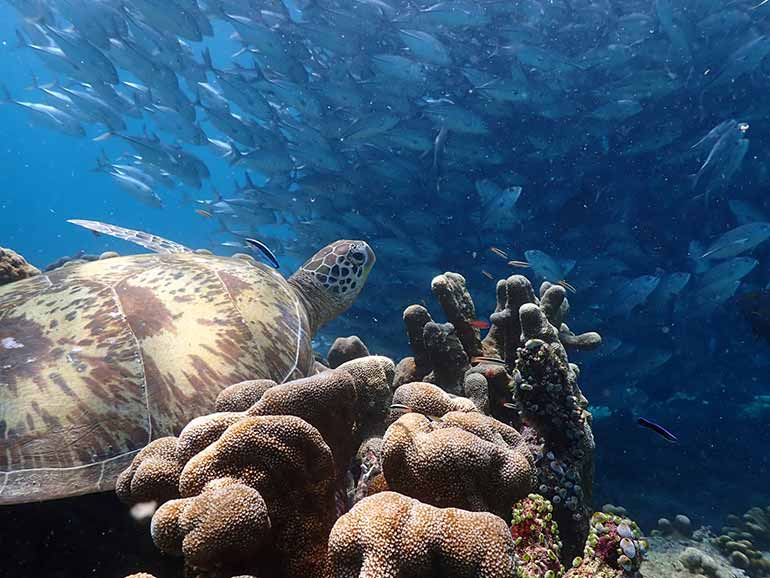
Sipadan Island is located off the east coast of Borneo, in the Malaysian state of Sabah. Most people fly in to Tawau Airport, which has daily connections to Kuala Lumpur and Kota Kinabalu airports. From Tawau Airport it’s just over an hour drive to reach Semporna Town – which is the gateway to diving Sipadan and the surrounding islands.
If you’re travelling around Borneo on a budget you can also reach Semporna by bus from Kota Kinabalu, Sandakan or Tawau. Local buses are cheap and it’s fairly easy to buy tickets – something to consider, if you’ve got the time and don’t mind a bit of a bumpy ride.
If you are on a very tight budget you can choose to stay in Semporna whilst exploring the different islands, or you can use it as a short stop over on your way to Mabul Island – which is where most people choose to base themselves to explore Sipadan.
Mabul is about an hour boat journey away from Semporna, and it is where you’ll find most dive resorts! There are no resorts on Sipadan itself, and it is not possible to stay overnight on the island as it’s a national park.
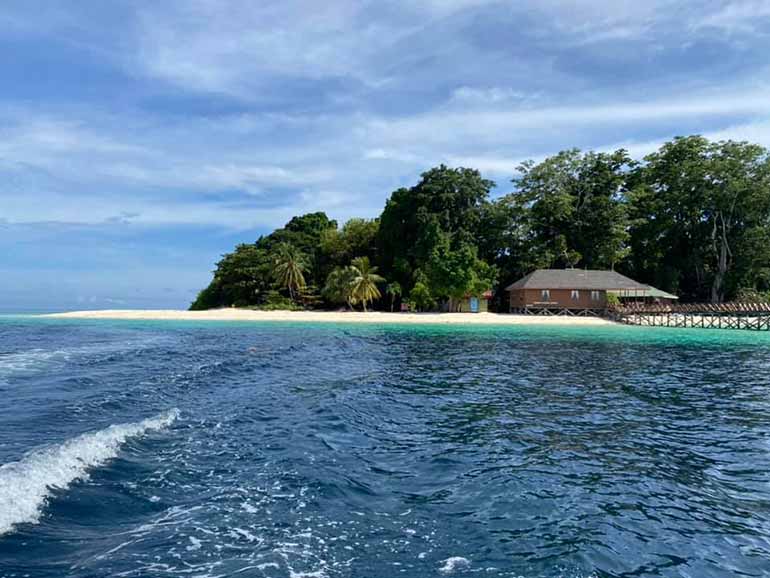
Scuba Junkie Mabul Beach Resort offers the perfect base to explore Sipadan and its neighboring islands. The resort has many different room types to suit all different budgets. Backpackers on a shoe-string budget (or simply those who love to socialize and meet new people) can choose to stay in our comfortable dorm rooms. If you prefer a bit of privacy there are both private fan and AC en-suite rooms with great value for money, and for those seeking affordable luxury there are two VIP rooms with sea-view.
Accommodation at Mabul Beach Resort comes with full board – including breakfast, lunch, dinner and homemade snacks throughout the day with free refill of water, tea and coffee 24/7! The open plan restaurant and the two panoramic bars offers plenty of chance to meet new people and hang out with your dive buddies. For those seeking a quiet moment, you can hang out on the beach or in the hammock on your private balcony. With these all-inclusive packages you can worry less about the logistics, and focus more on relaxing and enjoying the incredible diving this area has to offer!
When you’re choosing where to stay, and whom to dive Sipadan with, make sure you do your research! A good place to start is to read honest customer reviews on TripAdvisor on the companies you are considering. Keep in mind things such as divers to dive guide ratios, safety procedures, standard of rental equipment and how long your dives will be (many operators do a maximum of 45 minutes per dive, even if you’ve still got air left). Cheaper does not always equal better, so make sure you ask the right questions before booking!
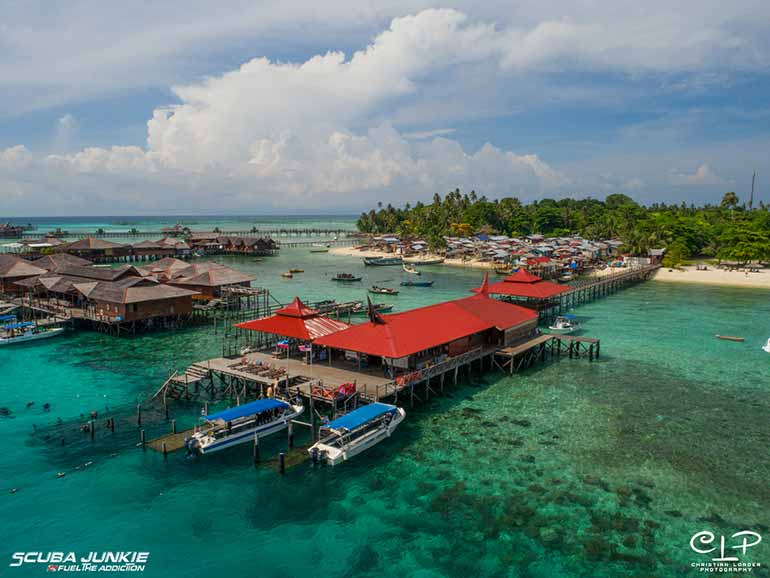
Sipadan is a marine protected area, and entry to the island is limited to 176 visitors per day. In order to visit the island you need a Sipadan permit acquired from Sabah Parks. The daily limit prevents excess stress on the reefs and the marine life, caused by too many divers and tourists.
With Sipadan being one of the best dive spots in the world, and there being limited available spaces each day it is important that you plan your trip early enough to secure a permit! For many divers, a holiday to Borneo is a once in a lifetime trip, and the last thing you would want is to finally turn up on site, only to find out there are no Sipadan permits available…
Here are our top tips for securing your golden ticket to diving Sipadan:
To make sure you get a hold of a Sipadan permit, the best tip we have is to book a package with a dive resort which guarantees your permit! At Scuba Junkie, Sipadan permits are allocated via all-inclusive Sipadan diving packages starting at 4 days/3nights. They include accommodation, full meals, equipment rental, 3 dives a day and a guaranteed Sipadan permit! No hassle, no stress and no extra work from your side – it’s as simple as contacting us with your preferred dates, and we will take care of the rest! Booking a dive holiday should be easy and FUN - not stressful!
Our next tip to securing a Sipadan permit is to book early! These bad boys are in high demand and they can sell out very quickly, especially in high season. We definitely recommend booking your trip a few months ahead of time.. You may get lucky and get a hold of a free spot with just a couple of weeks or days to spare – but why risk it?!
Generally speaking, a longer stay will increase your chances of getting a Sipadan permit, and staying for a week or longer may get you even two or three days of diving at Sipadan! After all you’ve travelled all this way – why not maximize your time diving the world’s best dive sites? Besides, going more than once will increase your chances of seeing those highly sought after hammerheads 😉
Planning your Sipadan holiday around low season will give you the best chances of diving Sipadan! This way you’ll beat the crowds, and maybe even save a buck or two! In low season you’ll often be able to get your hands on a permit with much less notice than in busier times. High season in July/August and during Christmas/New Years are the busiest times here. Other peak times include Chinese New Year - lasting around a week usually in Jan/Feb, Easter holidays and “Golden Week” - lasting around a week in early October.
If you wish to come and dive Sipadan during peak season (which can be a lot of fun as you’ll meet many new dive buddies) – be prepared to plan your trip and book a few months in advance!
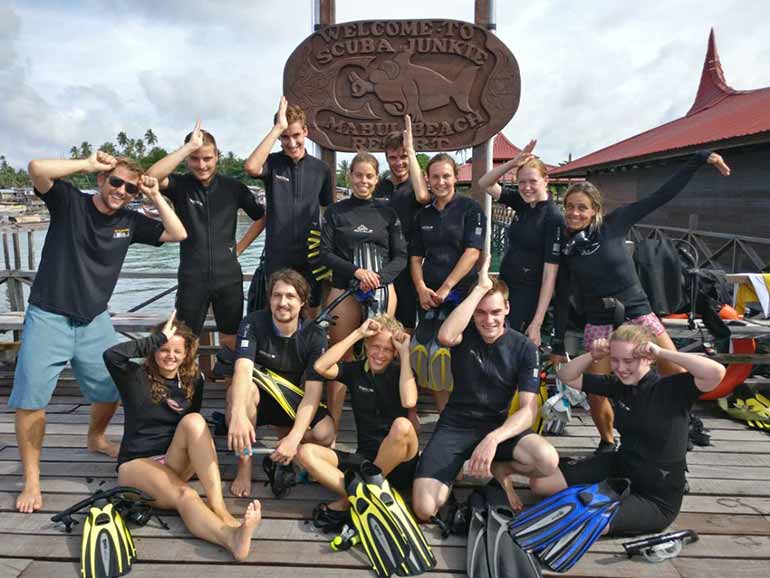
Since the first of October 2022, the minimum certification level you need to dive at Sipadan is Advanced Open Water (or equivalent). Some of the dive sites are definitely considered more advanced – due to the steep topography and the strong currents often frequenting Sipadan. Because of the sometimes more challenging dive conditions, at Scuba Junkie we require all our guests to dive one day around Mabul/Kapalai before heading out to Sipadan. This gives you a chance to get comfortable in the water under easier conditions, get to know your dive guide, and to receive some tips from your guide if needed. At Scuba Junkie we keep group sizes to a maximum of 4 divers per guide, and we make groups based on diver level and experience for everyone’s safety and enjoyment!
As far as depth goes, you can see many of Sipadan’s most popular attractions at 18m or shallower – such as reef sharks, turtles, and the three big schools (the barracuda, jacks & bumpheads)! You may have a better chance of seeing bigger sharks and more pelagic fish (we’re talking about you Mr. Hammerhead!) if you dive deeper than 18m.
If you are not yet a diver, Mabul is a great place to learn how to scuba dive! Calm waters, affordable prices and the possibility to dive Sipadan after your certification – what more could you want?
We can arrange packages including both Open Water and Advanced certifications as well as Sipadan fun diving! Here you’ll find more info about these courses: Open Water certification, and Advanced Open Water certification!
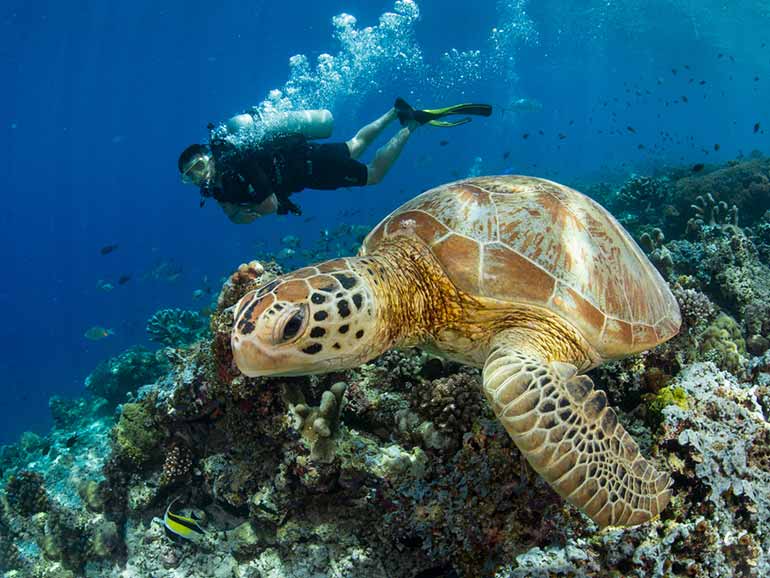
We are blessed with incredible diving at Sipadan all year round! Yep, that’s right – you can dive here at any time of the year and have an amazing experience! In nearly 15 years of operating we have never had to cancel a day trip due to weather! Borneo is nicknamed “The land below the wind” due to the fact we have no monsoon or typhoon season like many other parts of Asia. Being in a tropical country it can of course rain at any time of the year – however it is rare that it lasts longer than a couple of hours.
Weather is difficult to predict on a small tropical island in the middle of the ocean, and the weather patterns can change from year to year. The below are rough guidelines only…
February to June and October to December are often considered the “best times” to visit with calm seas, visibility between 15-40m, and water temperature rarely dropping below 28 degrees Celsius. Between December to February the water temperature drops a little lower, but rarely below 26 degrees Celsius.
July to September and December to January can see slightly bigger waves, and the visibility can be reduced during these months. That being said, this is not always the case, you can have absolutely fantastic conditions during these months as well – it differs from year to year! Besides, some of our best dives ever at Sipadan have been on lower visibility days, as this often means you get more close up encounters with certain marine life. Sipadan really is a true year-round destination, and we are sure that whichever time you choose to come and dive here you will have a fantastic time!

With 12 dive sites around the island we are blessed with choice, and they all have unique features making them worth visiting. Of course many divers coming to Sipadan only do a few dives here, so it’s important to maximize your time underwater!
Perhaps THE most famous and requested dive site at Sipadan, Barracuda Point is a site you’ll want to do over and over again! It starts out as a typical wall dive, before coming to an 18m deep sandy channel which often has strong currents pushing towards the corner of the island. White-tip reef sharks patrol the channel, and off the edge of the reef we’re often treated to some big grey reef sharks.
Strong currents bring in large pelagics and reef fish alike, and it truly feels like diving in an aquarium. The corals in the shallows are some of the most beautiful around the island, and this is often where we spot the school of bumphead parrotfish! As with anything at Sipadan they are HUGE – they can grow up to 1.5m and often travel in groups of hundreds!
Barracuda Point gets its name from the resident school of thousands of barracuda, which are frequently seen at the end of the channel, converging in a tornado-like formation, large enough to block out the sun. This epic sight will make even the most experienced divers jaws drop!

Just a few meters away from the beach, the wall at Drop Off plunges straight down to the sea floor at 600m and the topography of this dive site is simply stunning. The dive starts by exploring the entrance of Turtle Cave, named after the turtle skeletons found inside – unfortunate souls who entered the cave and never found their way out.
The cave goes deep through the island and to enter fully you must be a trained cave diver. However, even swimming just a few meters in to the entrance can be a thrilling experience as you look back and see the blue panorama framed by the cave walls. Often you’ll share the space with a few white-tip reef sharks and a school of jackfish.
Turn right at the cave exit, and continue along the steep wall towards Barracuda Point. Marvel at the sheer size of the wall and its diversity of coral, turtles and reef fish – but don’t forget to look up! You may find yourself in the middle of hundreds of bumpheads munching away at the reef, and if lucky you may finish the dive off surrounded by the barracuda tornado.
When there was still resorts on Sipadan (back in 2004), this dive was regularly voted the best shore dive in the world!
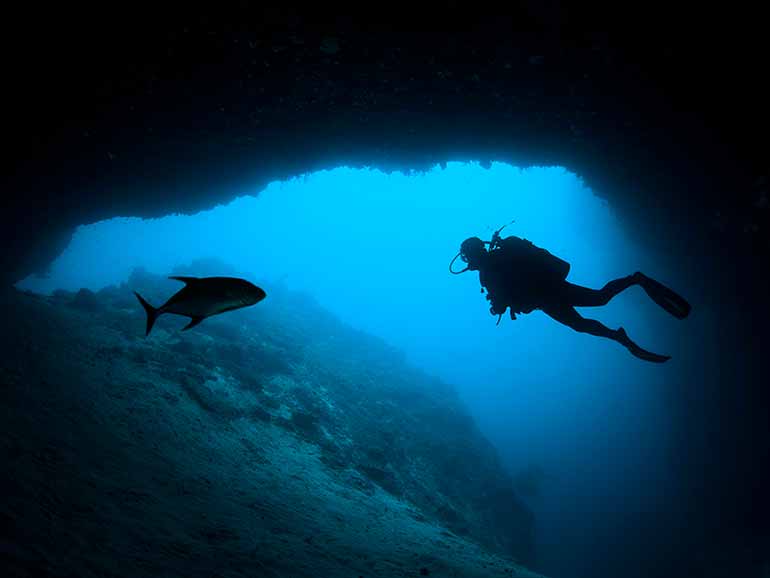
Although you can see big stuff at any of Sipadan’s dive sites, South Point offers one of the best opportunities for that special something! The strong currents frequenting this dive site attracts marine life of all sizes. From schooling grey reef sharks, regular hammerhead encounters and larger rays, this is one of our favourite sites to venture out from the wall into the blue in search for bigger pelagics!
Once you reach the point towards the end of the dive, look out for the resident school of jackfish (bigeye trevally). This is definitely one of the highlights of any day at Sipadan - it’s like sensory overload as you swim in the middle of the thousands of fish. With flashes of silver all around you, and often white-tip reef sharks shooting through the school as fast as lightning together with giant trevallies, this is a truly unique experience!
The jackfish are not shy towards divers and often you can spend a good amount of time swimming through the school. Just keep your dive buddies in sight - it’s quite easy to lose track of each other with all that action around you!
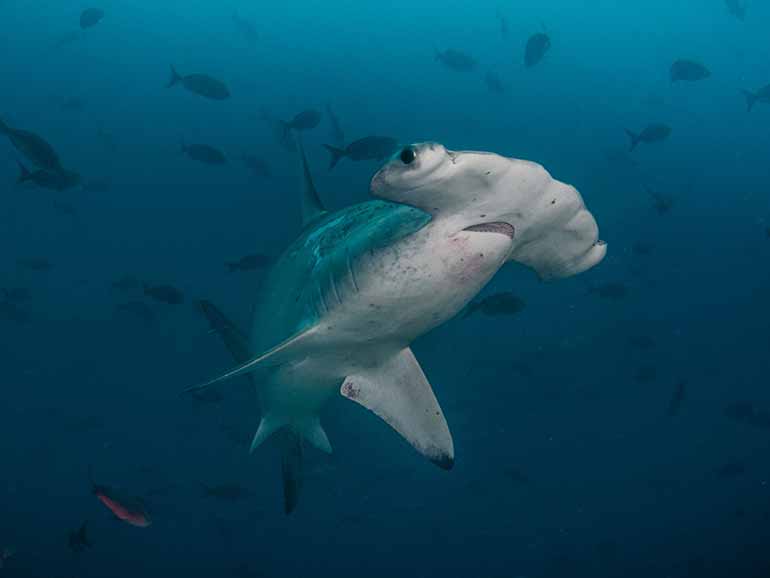
With dive sites such as Hanging Garden, West Ridge, Lobster Lair and Staghorn Crest, there is so much to discover on the west side of Sipadan. The west side of Sipadan is where the wall drops the deepest, closest to the island. You’ll see plenty of turtles, reef sharks and schooling fish here and it is also a good place for bigger encounters out in the blue!
If you come along for a trip with us we’ll take you to our secret spot, where we’ve had more hammerhead encounters than anywhere else on the island!!
Coral Gardens, White-tip Avenue, Mid Reef and Turtle Patch offer some of the most pristine coral around the island. Schooling baby grey reef sharks often frequent this side of Sipadan, as do larger rays, giant trevallies, massive tunas and reef sharks making their way towards Barracuda Point. The dives here usually offer a good drift, and on good days you can combine a few of them in one dive, drifting along with the current!
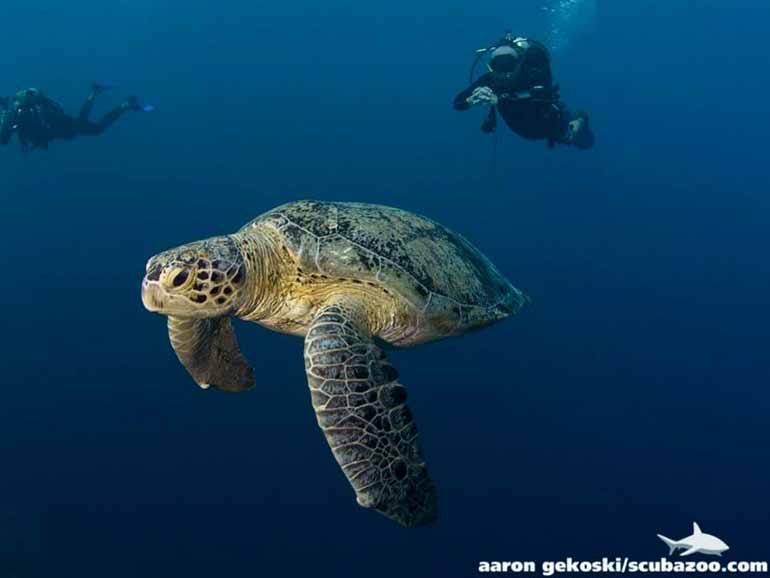
Absolutely! Snorkeling at Sipadan is fantastic, and most of the popular attractions can be seen shallow enough for snorkelers to enjoy as well as the divers. You’ll encounter plenty of reef sharks and turtles, and the three big schools of fish (the barracuda, bumpheads and jackfish) often hang out just at the edge of the reef – giving you a great opportunity to snorkel with them!
The coral in the shallows around the island are some of the most pristine and colourful you’ll find in the area, and there are so many colourful reef fish you’ll feel like you’re swimming in an aquarium! If you enjoy freediving, Sipadan sure is the place to be – the deep walls and incredible topography offer exciting possibilities for exploring just with your mask, fins and snorkel!
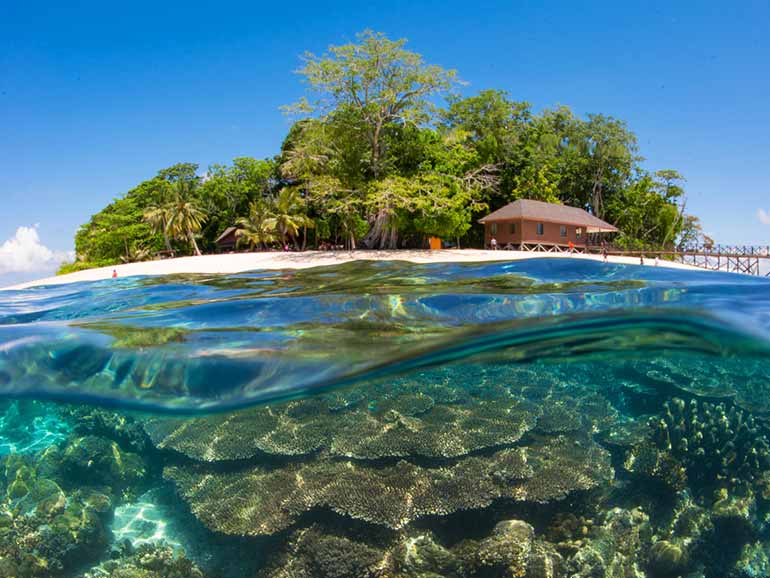
Famous for its incredible diving and snorkeling sites, there are other little known facts about Sipadan. Not only is the island a marine protected area, it is also a bird and reptile sanctuary. In fact Sipadan has been popular amongst bird watchers since the early 30’s, long before scuba divers arrived at the scene!
Another thing many are unaware of is that there is a huge turtle hatchery on Sipadan, managed by Sabah Parks. The hatchery is located just a few hundred meters from the jetty, however it is not accessible to tourists. Sipadan is a haven for nesting turtles, and we regularly see turtle tracks on the beach in the mornings – a sign that a female turtle has very recently been up on the beach to nest.
The turtles come up on the beach at night time to lay their eggs. The eggs are then collected by park members, and relocated to the dedicated turtle hatchery area, where they are protected from predators like birds, lizards and other animals. Once the nests hatch, the baby turtles will be released in to the ocean – hopefully to return a few years later!
As for the rest of Sabah, there is a huge diversity of activities to do! Whether you just want to chill on the beach, climb Mt. Kinabalu (one of the highest mountains in SE Asia), or travel deep into the rainforest in search of pygmy elephants, orangutans and other endemic animals - we’re sure you’ll find something that excites you. Borneo is a very special place, and has so many different places that are worth discovering!
For more inspiration on activities and tours to do in Sabah other than diving, check out our article on land tours here.
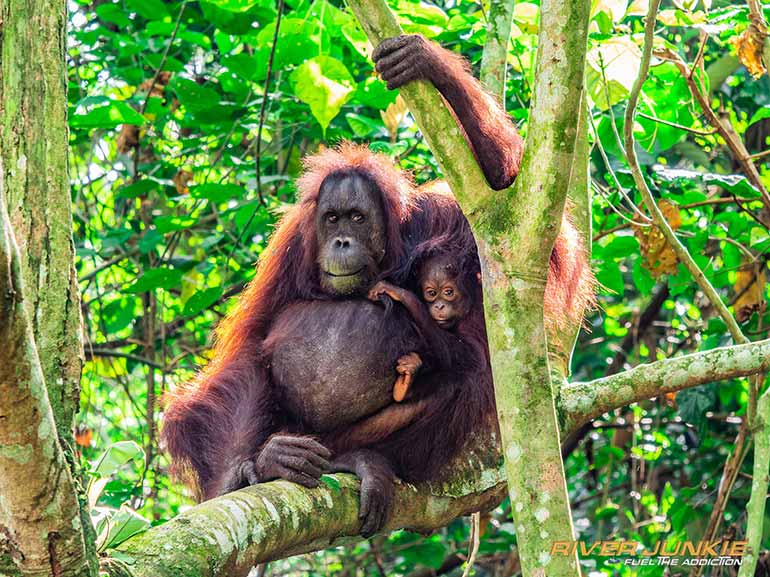
Other dive sites in the area are often overshadowed by the mighty Sipadan, however there are some really incredible spots to discover in the area! You’ve got Mabul which is home to a plethora of marine life, large and small. If you’re into macro critters, this is THE place to be! Common finds are frogfish, octopus, flamboyant cuttlefish, and ghost pipefish just to name a few. Shrimps, crabs and crazy nudibranchs can be found in every corner, and Mabul’s green turtle population is massive, with individuals growing up to 1.5 meters!!
Kapalai is another favourite, with beautiful sloping reefs on the south side, combined with the “House Reef” which is home to some of the coolest macro critters around. If you’re into underwater photography or simply just enjoy watching these weird and wonderful creatures you will love Kapalai!
More info on the different dive spots can be found here!

We hope you have found this blog post helpful, and that your holiday planning will now be a little easier… Regardless of your dive experience, whether you’re a complete beginner or a dive professional, these dive sites offer some of the most amazing dive experiences on the planet. If you love scuba diving, Sipadan Island simply MUST be on your dive bucket list!
For more information about the island, or to guarantee your next Sipadan permit - contact us today via the form below!
As a PADI Dive Instructor you are able to teach a range of courses, from taking people on their first ever Discover Scuba Dive, to training and mentoring future PADI Divemasters. These courses will challenge and test you in a range of ways, as well as expanding your skills in ways you couldn't imagine. But let's start at the beginning - a PADI Discover Scuba Diving (DSD) experience.
The DSD programme allows those who are not sure if they want to commit to the Open Water course to try diving. It requires no classroom time and can be done in just one morning. The customer is provided with basic diving theory to ensure they remain safe whilst underwater.
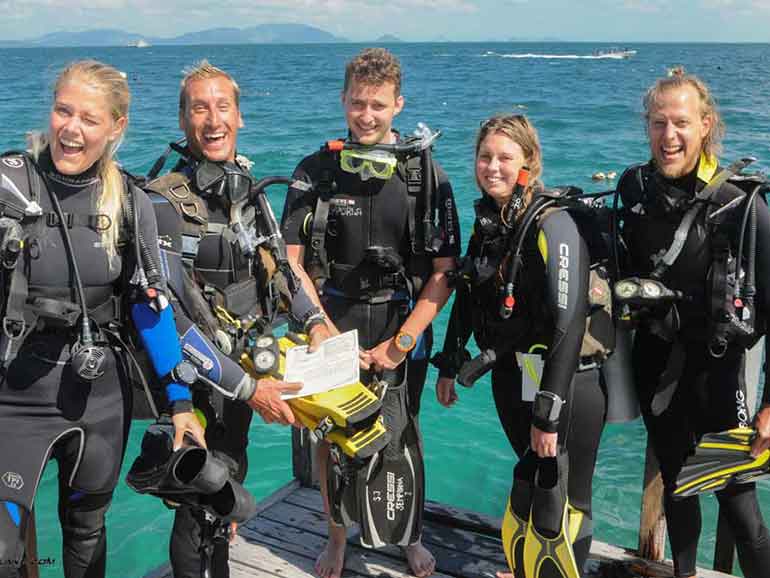
The day starts at 8.30am. Staff and interns alike come together to set up the jetty for the days diving. Tanks are collected from our compressor room, and BCDs and regulators are brought out from the equipment room. The energy on the jetty in the morning is infectious, everyone is excited about the upcoming day of diving. As dive professionals we love to share our passion with other divers, and that's what these days are about.
There is no classroom time for the DSD, so customers are met on the jetty. From there we take them to our shaded briefing area - the sun can be unforgiving at times! Away from the hustle of the jetty you are able to discuss with your students their feelings about their first ever dive. Whilst some may be fearless, more often than not there are some apprehensions. Taking your first breaths underwater can be a nerve racking experience - doing something that your body has been told for its entire life that it cannot do! As an instructor - someone who is borderline growing gills - we have to learn to understand this feeling.
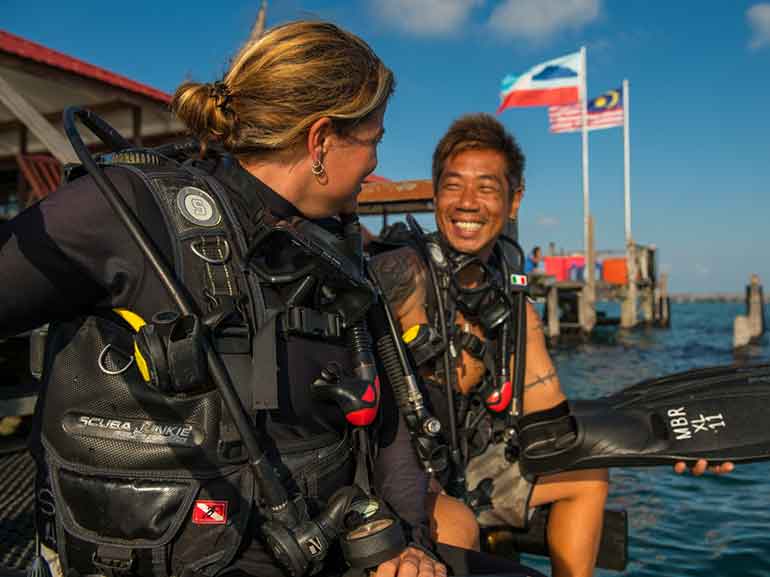
In the DSD briefing, our students are given an introduction to the physics of diving and what happens to our bodies, as well as information on how to be a safe diver. There is the delicate balance of making someone feel safe, but ensuring they understand that there are some serious risks involved in diving. Once the safety briefing is complete you then take them through some of the basic diving skills. Having them complete a regulator clearing skill, regulator recovery and a mask clearing skill means they are equipped to deal with the minor discomforts that divers can face in the water. To instructors these dive skills may seem simple, but for people who have rarely spent time in the water it can be a challenge. Helping people overcome there fears and difficulties that they face during these experience is one of the most rewarding aspects of being an Instructor.
Once the skills are completed it's time to take people on their first dive! This is a fantastic experience for all those involved. Showing people their first turtles, their first schools of stunning colourful fish makes and their expressions as you do so is one of the greatest parts of teaching. Keeping your student close and ensuring they feel safe is imperative. But of course this is a joyful experience, a day that people will treasure.
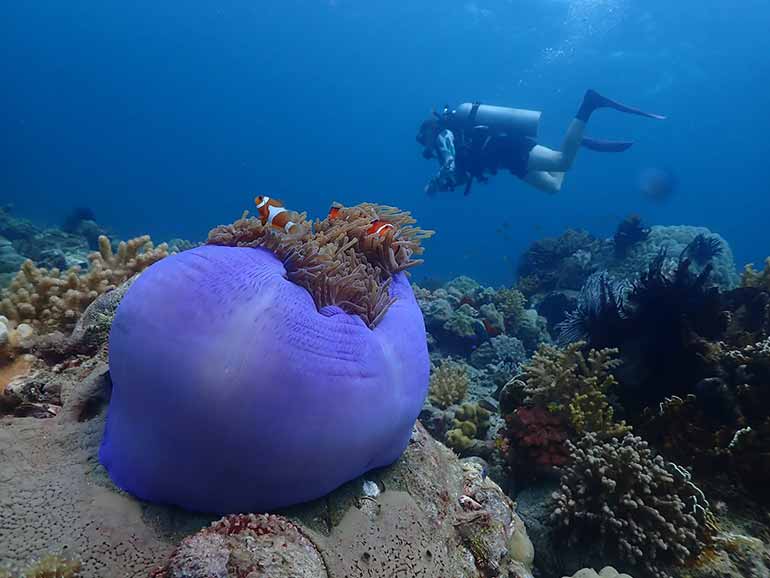
The DSD experience is two dives, the first is done on our House Reef. Swimming over sand around sunken boats and large structures that have attracted a plethora of life. Huge turtles sit surrounded by schools of blue striped snapper. Angelfish and butterfly fish flash their colours as they weave in-between the structures. Eels poke their heads out from underneath tyres. There is an endless amount of things to see. On the second dive we take our Discover Scuba Divers on a coral reef dive. Froggies is a shallow reef this sits to the West of our jetty. Along here we see huge schools of two spot snapper, beautiful corals, turtles, octopus and cuttlefish, amongst many other things!
After two dives everyone is ready for lunch. This is a chance to discuss with these new divers how they feel about the diving day and explain to them the beautiful things that they saw. After lunch divers are given the chance to go for a third dive. Sometimes they even get to go out on one our our boats. After the last dive its time for the equipment break down. The customers go off to the beach to relax whilst staff and interns wash gear and clears tanks from the boats. Everyone works as a team and it's takes less than 30 minutes. It gives staff a chance to discuss their day and speak to the other customers who are still milling around the jetty soaking up the buzzing atmosphere.

Once the busy day is done it's time to head up to the lovely Scuba Junkie bar. An ice cold beer shared with your divers is a great way to finish the day. Everyone comes together to discuss the days diving, the intriguing fish that they saw and the rewarding experiences they have had with their divers. The range of people who you experience whilst working as a PADI Open Water Scuba Instructors is truly unbelievable at times. Watching people overcome their fears face on and the challenges they overcome is a rewarding experience.
For more information send us an email: info@scuba-junkie.com. We hope to see you soon!
